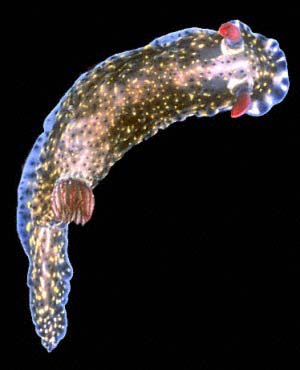
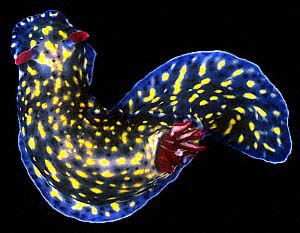
Hypselodoris obscura
Stimpson, 1855
Order: NUDIBRANCHIA
Suborder: DORIDINA
Family: Chromodorididae
DISTRIBUTION
Southeastern Australia from Southern Queensland to southern New South Wales.
PHOTO
UPPER: Callala Point, Jervis Bay, southern New South Wales, November 1984.
LOWER: Solitary Is, Coffs Harbour Region, northern New South Wales, March 1988
PHOTOS: Bill Rudman.
Probably part of a complex of related species including Hypselodoris saintvincentius found in South Australia, and Hypselodoris infucata which has a wide Indo-West Pacific distribution.
The colour form in the upper photo, with a translucent greyish background colour is found throughout the species' range. The blue colour form (lower photo) is common only in the northern part of its range (southern Queensland and northern New South Wales), and only on rare occasions is seen as far south as Sydney. The photo of both colour forms mating (see Akos Lumnitzer's 28 Nov 1998 message) indicates that they are colour forms of the same species.
Reference:
• Rudman, W.B. (1984) The Chromodorididae (Opisthobranchia: Mollusca) of the Indo-West Pacific: a review of the genera. Zoological Journal of the Linnean Society, 81: 115-273.
Rudman, W.B., 1998 (November 28) Hypselodoris obscura Stimpson, 1855. [In] Sea Slug Forum. Australian Museum, Sydney. Available from http://www.seaslugforum.net/find/hypsobsc
Related messages
Hypselodoris obscura from sthn Queensland
June 2, 2009
From: Gary Cobb
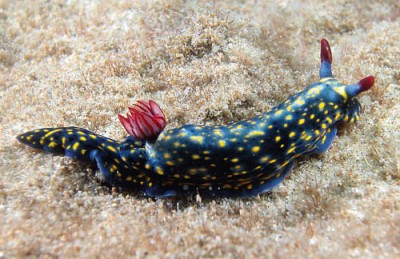
Concerning message #21208:
Hi Bill and everyone!
I present to you all Hypselodoris obscura which very common in this area. It has been found at all dive and intertidal sites. You can find it on almost every dive.
Locality: Noosa to Woody Pt Sunshine Coast, 30 m to 30 mm, Queensland, Australia, Pacific Ocean, 26 May 2009, Subtidal and Intertidal. Length: 4 mm to 60 mm. Photographer: Gary Cobb and David Mullins.
I have included photos of it actually laying it's egg mass, eating with it's buccal mass extended and a great shot of David Mullins on a red sponge. I don't think it is feeding on this red sponge, maybe checking it out.
Cheers
Gary
gary@nudibranch.com.au
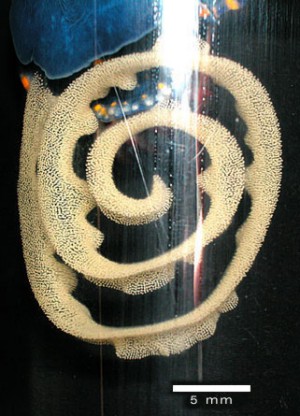

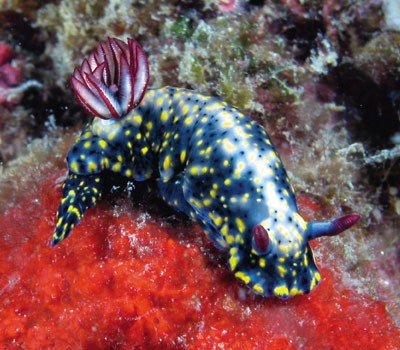
Thanks Gary,
I tend to agree that the animal on the red colony is not feeding - I assume it's a sponge but perhaps it's an ascidian? Interestingly, the white 'stuff' the animal with its everted oral tube is on could well be the food sponge. It doesn't look like a sponge at all but the only record we have of H. obscura feeding is an earlier message from the Atkinsons [message #15878] which shows are rather white 'rock-like' colony of a species of Dysidea, very similar in appearance
Best wishes,
Bill Rudman
Hypselodoris obscura from Jervis Bay
February 27, 2008
From: James McMahon
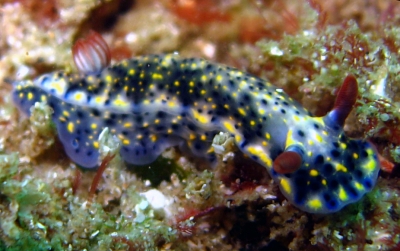
Hi There,
I photographed this specimen in Jervis Bay, New South Wales, Australia on 27 October 2007. At this stage I can't remember the exact dive site, however it might have been "The Docks".
Locality: Jervis Bay, Huskisson, 15 m, New South Wales, Australia, Pacific Ocean, 27 October 2007. Photographer: James McMahon.
The main reason that I thought it might be interesting is that it appears to be the "blue form", and you had commented that this form was rarely seen as far south as Sydney. Although on a second look I could also be mistaken.
Thanks for your fantastic site.
James
james.mcmahon@verizonbusiness.com
McMahon, J.A., 2008 (Feb 27) Hypselodoris obscura from Jervis Bay. [Message in] Sea Slug Forum. Australian Museum, Sydney. Available from http://www.seaslugforum.net/find/21208Thanks James,
We still have much to learn about about even the most simple aspects of the life of most species. Photo records like yours can help us slowly build up a better idea of their distribution.
Best wishes,
Bill Rudman
Hypselodoris obscura feeding
February 20, 2006
From: L. & D. Atkinson
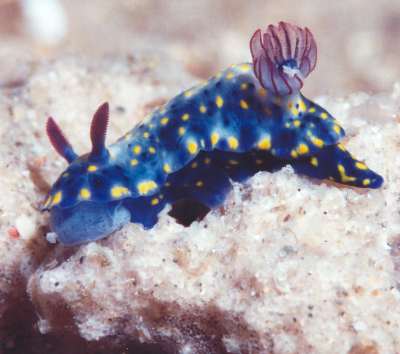
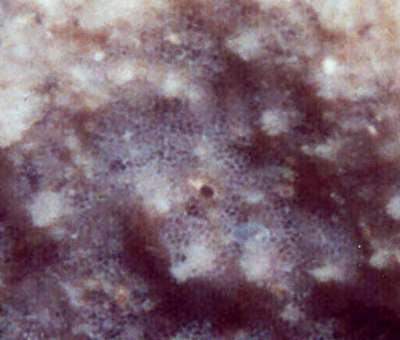
Dear Bill,
We came across the Hypselodoris obscura which appears to be feeding. There weren't any messages posted showing it feeding and you don't mention it's food in the fact sheet so we thought these photos might be of interest. The "long shot" was to show the sponge clearly. The close up shows what we thought was the bucal bulb everted for feeding. Most summer seasons we see a few of these darker coloured H. obscura in the Port Stephens area.
Locality: The Pipeline, Port Stephens, 10 m, New South Wales, Australia, Pacific Ocean, 11 February 2006, Sandy bottom with scattered sponges, soft corals and ascidians. Length: 15 mm. Photographer: Leanne & David Atkinson.
Regards,
Leanne & David Atkinson
atk@hunterlink.net.au
Atkinson, L. & D., 2006 (Feb 20) Hypselodoris obscura feeding. [Message in] Sea Slug Forum. Australian Museum, Sydney. Available from http://www.seaslugforum.net/find/15878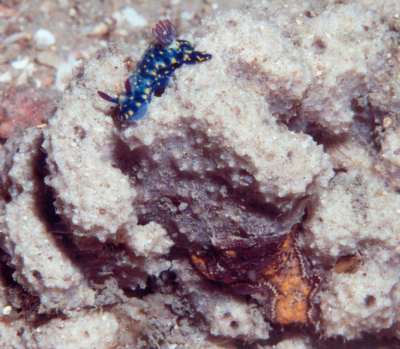
Dear Leanne & David,
Thnaks for this. It's food sponge seems to be one of those very cryptic ones which are hard to distinguish from the background. I suspect the darker parts of the colony, which show the sponge structure, are where the slug has been eating. It is almost certainly a species of Dysidea, but I will get it checked
Best wishes,
Bill Rudman
Hypelodoris obscura from Port Stephens
December 12, 2003
From: Leanne & David Atkinson
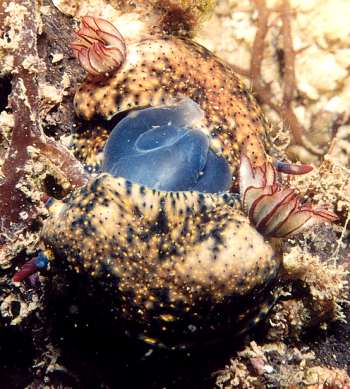

Dear Bill,
With the recent messages about Hypselodoris obscura we checked what you already had on the site and noticed there weren't any from the Port Stephens area. We get quite a few here in summer in the shallows. The duller colour variation is more common.
Here are some photos of Hypselodoris obscura mating. They were on the underside of an old piece of oyster rack that had obviously been unproductive for some time, by the amount of growth on it.
Photo details :
Date: 27 December 2002
Locality: Fly Point Marine Reserve, Port Stephens, NSW, Australia.
Depth: 9m Water Temperature: 19 Degrees C.
Tide: High 3:00pm 1.4m
Yours sincerely,
Leanne & David Atkinson
atk@hunterlink.net.au
Atkinson, L. & D., 2003 (Dec 12) Hypelodoris obscura from Port Stephens. [Message in] Sea Slug Forum. Australian Museum, Sydney. Available from http://www.seaslugforum.net/find/11645Thanks Leanne & David,
The mating apparatus is very blue in these animals. It is interesting that in some animals, the parts of the body that evert at times - parts of the reproductive apparatus and the oral tube - are distinctly coloured like this, while in other animals they are colourless. It seems to be an individual idiosyncracy rather than a character of a particular species
Best wishes
Bill Rudman
Hypselodoris obscura from Wallis Lake
December 1, 2003
From: Peter Barnes
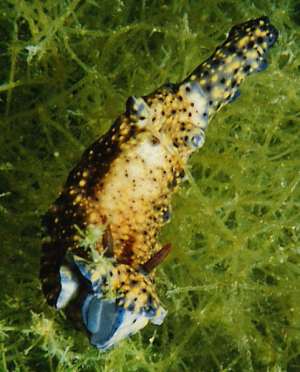
Dear Dr Rudman,
I came across this nudibranch in Wallis Lake on the mid north coast of New South Wales [Australia]. The few individuals I found were all on sponges (Mycale sp.) in relatively shallow water (less 2m) amongst a dense bed of Charophytes (Lamprothamnion sp.). This photograph was taken in January 2002. The salinity of Wallis Lake is usually close to that of seawater. I was wondering whether you might be able to identify it for me.
Thanks.
Peter Barnes
pbb47@uow.edu.au
Barnes, P,, 2003 (Dec 1) Hypselodoris obscura from Wallis Lake. [Message in] Sea Slug Forum. Australian Museum, Sydney. Available from http://www.seaslugforum.net/find/11548Dear Peter,
This is Hypselodoris obscura, a species endemic to south-eastern Australia. I am interested in your observation about it always being on a particular sponge. I would be surprised if the sponge was a species of Mycale, as chromodorid nudibranchs feed on sponges which lack siliceous spicules. If you have any photos of the nudibranch on the sponge I would be interested in seeing them as we are short of information on the specific feeding habits of most species of opisthobranch and your observation would be a useful bit of information.
Best wishes
Bill Rudman
Hypselodoris obscura from Jervis Bay
November 27, 2003
From: Sue Newson
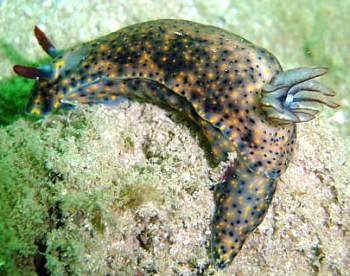
Hi Bill,
Again, another one from the same site as my previous message. This Hypselodoris obscura was photographed during the day dive, although I did see it on all three dives.
Location - Jervis Bay (southern side) [New South Wales, Australia]
Depth 12m
Water Temp - 18*C
Time - 10am
Date - 24th November 2003
Sue Newson
snewson@shoal.net.au
Newson, S., 2003 (Nov 27) Hypselodoris obscura from Jervis Bay. [Message in] Sea Slug Forum. Australian Museum, Sydney. Available from http://www.seaslugforum.net/find/11503Thanks Sue,
Bill Rudman
Meaning of Hypselodoris
June 10, 2003
From: Malo Hosken
Hello Dr Rudman
I am currently doing an assignment on the nudibranch Hypselodoris obscura, found in south Queensland [Australia]. I wanted to know the meaning of the genus Hypselodoris. What does it stand for ?
I hope you can help me out,
Thank you,
Malo Hosken
s4015425@student.uq.edu.au
Hosken, M. , 2003 (Jun 10) Meaning of Hypselodoris. [Message in] Sea Slug Forum. Australian Museum, Sydney. Available from http://www.seaslugforum.net/find/10191Dear Malo,
Many journal editors now insist that authors of new names provide a 'meaning' or 'etymology' for new names. In earlier times this was not often done. I'm afraid that in the case of Hypselodoris the whole description was particularly shabby.
Stimpson (1855) has a one paragraph description of Goniodoris? obscura from Port Jackson [Sydney Harbour], followed by the following 3 sentence discussion:
"This species, with another closely allied and occurring in the same locality form a genus probably new. It differs from Goniodorus (sic), in having retractile tentacula, and in the greater development of the mantle; and from Doris by the elevated, oblong quadrangular shape of the body. I would propose for it the name of Hypselodoris."
So basically the author didn't give any indication on the origin of the name. Stimpson does mention that it differs from the genus Doris by the elevated shape of the body so it is possible that Hypselodoris is based on hypsos - the Greek word for height - as in 'high doris' but that is only a guess.
Doris was a Greek sea goddess. The genus Doris was an early Linnaean genus into which many 'dorid' nudibranchs were initially placed.
Best wishes,
Bill Rudman
Hypselodoris obscura from Jervis Bay, NSW
April 16, 2001
From: Des Paroz
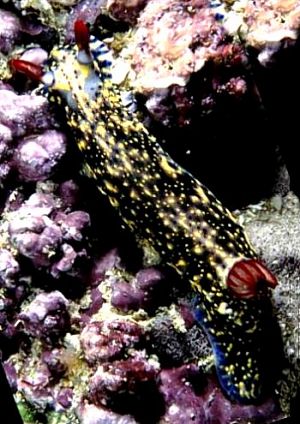
Hi Bill
The previous message on this critter included a photo taken by Kevin Withnall on his you-beaut digital camera - downloaded to his PC before we even left the dive boat.
After getting home, I got my slides developed and have now gotten around to scanning my shots of this animal - a particularly striking nudi in my opinion. I still think the slide shot provides better colour contrast, so am submitting this photo if you want it for the Forum.
It's my first recollection of encountering this animal - is it typically found further north and been washed down with the warm currents?
Best regards
Des
des@paroz.com
Paroz, D., 2001 (Apr 16) Hypselodoris obscura from Jervis Bay, NSW. [Message in] Sea Slug Forum. Australian Museum, Sydney. Available from http://www.seaslugforum.net/find/4169Dear Des,
Hypselodoris obscura is a spectacularly coloured species, but it is an endemic to southeastern Australia, basically New South Wales. It is very similar externally to a widespread tropical species Hypselodoris infucata but our present understanding of their relationships suggests that it is a distinct species.
Best wishes,
Bill Rudman
Hypselodoris obscura from Jervis Bay
April 2, 2001
From: Des Paroz

Hi Bill
A mate and I were having a dive today at The Docks, Jervis Bay [southern new South Wales, Australia], and we came across this nudi. Depth was about 16m, and was found on boulders to the side of the wall. Water temp was 22C. The photo is actually Kevin Withnall's, but since he's got a digital uw camera, I thought we'd get the posting straight up.
I think it might be Hypselodoris obscura. Can you confirm this for me?
Best regards
Des
des@paroz.com
Paroz, D., 2001 (Apr 2) Hypselodoris obscura from Jervis Bay. [Message in] Sea Slug Forum. Australian Museum, Sydney. Available from http://www.seaslugforum.net/find/4103Dear Des,
Yes this is H. obscura
Bill Rudman
Hypselodoris obscura from Jervis Bay, NSW
December 22, 2000
From: Ken Kates
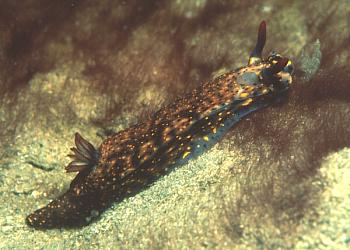
I photographed the attached nudi last weekend [12 December 2000] on the southern scallop beds in Jervis Bay [New South wales, Australia]. Actually I saw two. Depth 18m, sandy bottom. Could you please ID?
Ken Kates
krkates@shoal.net au
Kates, K., 2000 (Dec 22) Hypselodoris obscura from Jervis Bay, NSW. [Message in] Sea Slug Forum. Australian Museum, Sydney. Available from http://www.seaslugforum.net/find/3389Dear Ken,
This is Hypselodoris obscura, a fairly common chromodorid in New South Wales waters.
Best wishes,
Bill Rudman.
Hyselodoris obscura laying eggs
August 18, 2000
From: Stuart Hutchison
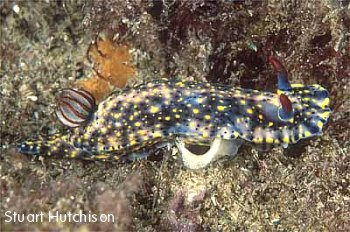
Dear Bill,
Here's a shot of Hypselodoris obscura laying eggs near Tathra Jetty (New South Wales - Australia) in April 2000. Depth 11m, size 50mm.
Regards,
Stuart
hutchco@tpg.com.au
Hutchison, S., 2000 (Aug 18) Hyselodoris obscura laying eggs. [Message in] Sea Slug Forum. Australian Museum, Sydney. Available from http://www.seaslugforum.net/find/2882Thanks Stuart,
Bill Rudman.
Unknown species from Port Hacking, NSW
September 2, 1999
From: Erik Schloegl
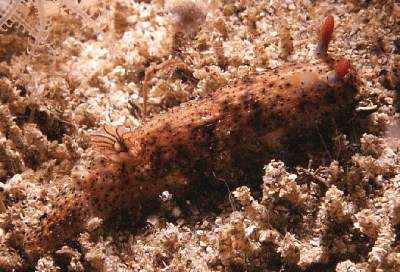
Hi!
I've been meaning to ask this list for advice
on species ID for a long time, and now finally managed to get some of my photos scanned...
The attached photo was taken at Ship Rock Aquatic Reserve at Port Hacking (just south of Sydney, Australia) last September. Ship Rock is situated in an estuary and the depth at the time was 13m, over sandy bottom. I've done quite a few dives there, but I've only seen this nudibranch once - there and not anywhere else. Couldn't find it in any of the usual books - can someone help? I estimate the animal's length at 3cm.
Cheers,
Erik
schloegl@maths.uts.edu.au
Schloegl, E., 1999 (Sep 2) Unknown species from Port Hacking, NSW. [Message in] Sea Slug Forum. Australian Museum, Sydney. Available from http://www.seaslugforum.net/find/1282Dear Erik,
A nudibranch from New South Wales! I was just thinking as I posted another group of interesting animals from Holland, New York and the Caribbean, that it was a while since we've had one from down under.
Your animal is a fairly pale example of Hypselodoris obscura, which was first described from Sydney Harbour, 150 years ago. Like many nudibranchs, it is sometimes quite common and other times impossible to find.
As you will see at the top of the page, it is one of a group of very similarly coloured species.
Best wishes,
Bill Rudman.
H. infucata in Wells & Bryce
March 16, 1999
From: Wayne Ellis
Hi Bill,
Intersting timing. I'm about to send out this month's issue of anNEWS in which I refer to comments in Terry Gosliner's 1999 paper on Hypselodoris. The paper notes H. infucata shown in W.A Sea Slugs (#139)is probably an undescribed species.
Regards
Wayne
glaskin@ozemail.com.au
Ellis, W., 1999 (Mar 16) H. infucata in Wells & Bryce. [Message in] Sea Slug Forum. Australian Museum, Sydney. Available from http://www.seaslugforum.net/find/672Hypselodoris obscura & H. infucata
March 12, 1999
From: Rebecca Johnson
Hi Dr. Rudman,
I was wondering is you could post a picture of the H. obscura specimen you sent me. It is AM C.144046. Do you still think H. obscura is limited to SE Australia?? Do you think the #140 in Wells and Bryce is H. obscura....or do you think everything outside of SE Aust. is H. infucata.....Thanks for any help you can give me.
Thanks,
Rebecca
rjohnson@mail.calacademy.org
Johnson, R., 1999 (Mar 12) Hypselodoris obscura & H. infucata. [Message in] Sea Slug Forum. Australian Museum, Sydney. Available from http://www.seaslugforum.net/find/671Dear Rebecca,
Firstly, by remarkable coincidence, the photo at the top of the page from Callala Bay, is the very animal you ask about.
Now about Hypselodoris infucata, Hypselodoris obscura and Hypselodoris saintvincentius. H. obscura seems to be restricted to New South Wales and the most southern part of Queensland. I know of records of H. saintvincentius in South Australia and southwestern Western Australia. Hypselodoris infucata seems to have a wide Indo-West Pacific distribution. One complication to this neat picture is that southerly currents and eddies can sometimes bring tropical species as far south as southern New South Wales on the east coast of Australia, and to South Australia by way of the Leuwin Current down the west coast.
Why don't I just accept they are all forms of one species? There is one consistent radular difference. Throughout its range from east Africa to at least Darwin in northern Australia, Hypselodoris infucata has a distinct tricuspid innermost lateral tooth while in H. obscura and H. saintvincentius the innermost lateral tooth is bicuspid.
Concerning the photos in Wells & Bryce:
#139, which they identify as H. infucata, from southwestern Australia, is H. saintvincentius.
#140, which they identify as H. obscura, from Dampier Archipelago in northwestern Australia, doesn't look like that species to me and is probably a colour form of H. infucata.
Best wishes,
Bill Rudman.
Colour forms of Hyps. obscura mating
November 28, 1998
From: Akos Lumnitzer
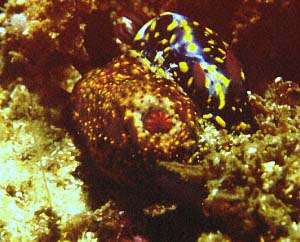
Dear Bill,
I dive regularly near the entrance to Botany Bay, Sydney and wondered if this photo of mating nudibranchs was of interest. It was taken on the east side of Bare Island, La Perouse, Sydney, in September 1998. I saw the animals there for 7-10 days then they disappeared.
Akos Lumnitzer.
AKOS72@hotmail.com
Lumnitzer, A., 1998 (Nov 28) Colour forms of Hyps. obscura mating. [Message in] Sea Slug Forum. Australian Museum, Sydney. Available from http://www.seaslugforum.net/find/335Thanks for the photo Akos, and for the others which I will put on the site as soon as possible. The most interesting thing is that it seems to be pretty good evidence that these two colour "forms" are the same species. Years ago I compared them anatomically and found no good differences but because they look so different in colour I had put them in the "too hard" basket to deal with later.
This is the sort of important observation that recreational divers and other "non-professionals" can make. As I have said before, photos of animals feeding, laying eggs etc are very welcome for the Sea Slug Forum as they will help us build up some of the basic natural history information which is so sadly lacking.
I have also posted information on and pictures of two very similarly coloured species, Hypselodoris saintvincentius and Hypselodoris infucata.
Thanks again,
Bill Rudman.
NOTE ADDED Nov 30: See Mike Miller's photo of mating Hypselodoris infucata .
Rudman, W.B., 1998 (Nov 28). Comment on Colour forms of Hyps. obscura mating by Akos Lumnitzer. [Message in] Sea Slug Forum. Australian Museum, Sydney. Available from http://www.seaslugforum.net/find/335